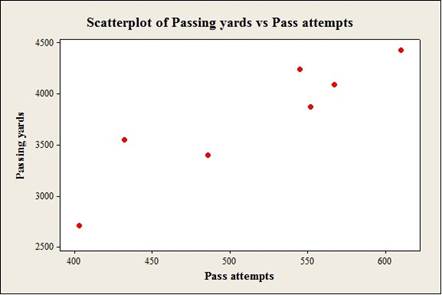
In Exercises 1–4, (a) display the data in a
1. The numbers of pass attempts and passing yards for seven professional quarterbacks for a recent regular season (Sourer: National Football League)

a.
To construct: The scatterplot for the variables the numbers of pass attempts and passing yards.
Answer to Problem 9.1.1RE
Output using the MINITAB software is given below:

Explanation of Solution
Given info:
The data shows the numbers of pass attempts (x) and passing yards (y) values.
Calculation:
Software procedure:
Step by step procedure to obtain scatterplot using the MINITAB software:
- Choose Graph > Scatterplot.
- Choose Simple and then click OK.
- Under Y variables, enter a column of Passing yards.
- Under X variables, enter a column of Pass attempts.
- Click OK.
From the scatterplot, it is observed that as pass attempts increases, the passing yards also increases.
b.
To find: The value of the linear correlation coefficient r.
Answer to Problem 9.1.1RE
The linear correlation coefficient r is 0.917.
Explanation of Solution
Calculation:
Correlation coefficient r:
Software procedure:
Step-by-step procedure to obtain the ‘correlation coefficient’ using the MINITAB software:
- Select Stat > Basic Statistics > Correlation.
- In Variables, select Pass attempts and Passing yards from the box on the left.
- Click OK.
Output using the MINITAB software is given below:

Thus, the Pearson correlation of the numbers of pass attempts and passing yards is 0.917 and P-value is 0.004.
c.
To describe: The type of linear association between the numbers of pass attempts and passing yards.
To interpret: The linear association between the numbers of pass attempts and passing yards.
Answer to Problem 9.1.1RE
There is a strong positive linear correlation between the numbers of pass attempts and passing yards.
As the numbers of pass attempts increase then the passing yards also increase.
Explanation of Solution
From, the scatterplot in part (a), it is observed that the horizontal axis represents the numbers of pass attempts and vertical axis represents the numbers of the passing yards. Also, it is observed that the numbers of pass attempts increase then the passing yards also increase. Also, the data points are scattered closely.
From part (b), it is observed that the linear correlation between the numbers of pass attempts and passing yards is 0.917.
Thus, there is a strong positive linear correlation between the numbers of pass attempts and passing yards
Want to see more full solutions like this?
Chapter 9 Solutions
Pearson eText for Elementary Statistics: Picturing the World -- Instant Access (Pearson+)
- Given your fitted regression line, what would be the residual for snake #5 (10 C)?arrow_forwardCalculate the 95% confidence interval around your estimate of r using Fisher’s z-transformation. In your final answer, make sure to back-transform to the original units.arrow_forwardCalculate Pearson’s correlation coefficient (r) between temperature and heart rate.arrow_forward
- A researcher wishes to estimate, with 90% confidence, the population proportion of adults who support labeling legislation for genetically modified organisms (GMOs). Her estimate must be accurate within 4% of the true proportion. (a) No preliminary estimate is available. Find the minimum sample size needed. (b) Find the minimum sample size needed, using a prior study that found that 65% of the respondents said they support labeling legislation for GMOs. (c) Compare the results from parts (a) and (b). ... (a) What is the minimum sample size needed assuming that no prior information is available? n = (Round up to the nearest whole number as needed.)arrow_forwardThe table available below shows the costs per mile (in cents) for a sample of automobiles. At a = 0.05, can you conclude that at least one mean cost per mile is different from the others? Click on the icon to view the data table. Let Hss, HMS, HLS, Hsuv and Hмy represent the mean costs per mile for small sedans, medium sedans, large sedans, SUV 4WDs, and minivans respectively. What are the hypotheses for this test? OA. Ho: Not all the means are equal. Ha Hss HMS HLS HSUV HMV B. Ho Hss HMS HLS HSUV = μMV Ha: Hss *HMS *HLS*HSUV * HMV C. Ho Hss HMS HLS HSUV =μMV = = H: Not all the means are equal. D. Ho Hss HMS HLS HSUV HMV Ha Hss HMS HLS =HSUV = HMVarrow_forwardQuestion: A company launches two different marketing campaigns to promote the same product in two different regions. After one month, the company collects the sales data (in units sold) from both regions to compare the effectiveness of the campaigns. The company wants to determine whether there is a significant difference in the mean sales between the two regions. Perform a two sample T-test You can provide your answer by inserting a text box and the answer must include: Null hypothesis, Alternative hypothesis, Show answer (output table/summary table), and Conclusion based on the P value. (2 points = 0.5 x 4 Answers) Each of these is worth 0.5 points. However, showing the calculation is must. If calculation is missing, the whole answer won't get any credit.arrow_forward
 Glencoe Algebra 1, Student Edition, 9780079039897...AlgebraISBN:9780079039897Author:CarterPublisher:McGraw Hill
Glencoe Algebra 1, Student Edition, 9780079039897...AlgebraISBN:9780079039897Author:CarterPublisher:McGraw Hill Holt Mcdougal Larson Pre-algebra: Student Edition...AlgebraISBN:9780547587776Author:HOLT MCDOUGALPublisher:HOLT MCDOUGAL
Holt Mcdougal Larson Pre-algebra: Student Edition...AlgebraISBN:9780547587776Author:HOLT MCDOUGALPublisher:HOLT MCDOUGAL Big Ideas Math A Bridge To Success Algebra 1: Stu...AlgebraISBN:9781680331141Author:HOUGHTON MIFFLIN HARCOURTPublisher:Houghton Mifflin Harcourt
Big Ideas Math A Bridge To Success Algebra 1: Stu...AlgebraISBN:9781680331141Author:HOUGHTON MIFFLIN HARCOURTPublisher:Houghton Mifflin Harcourt


